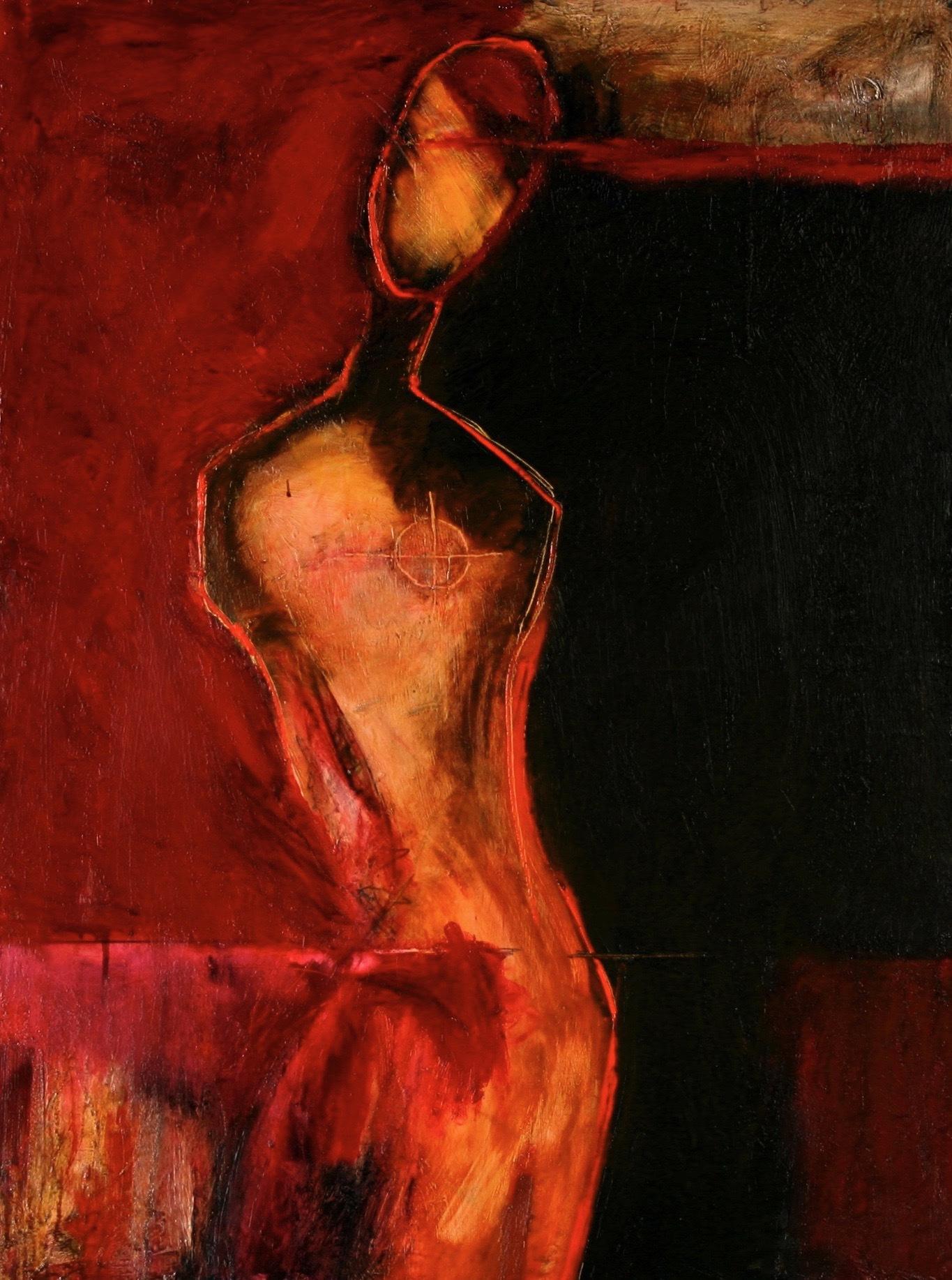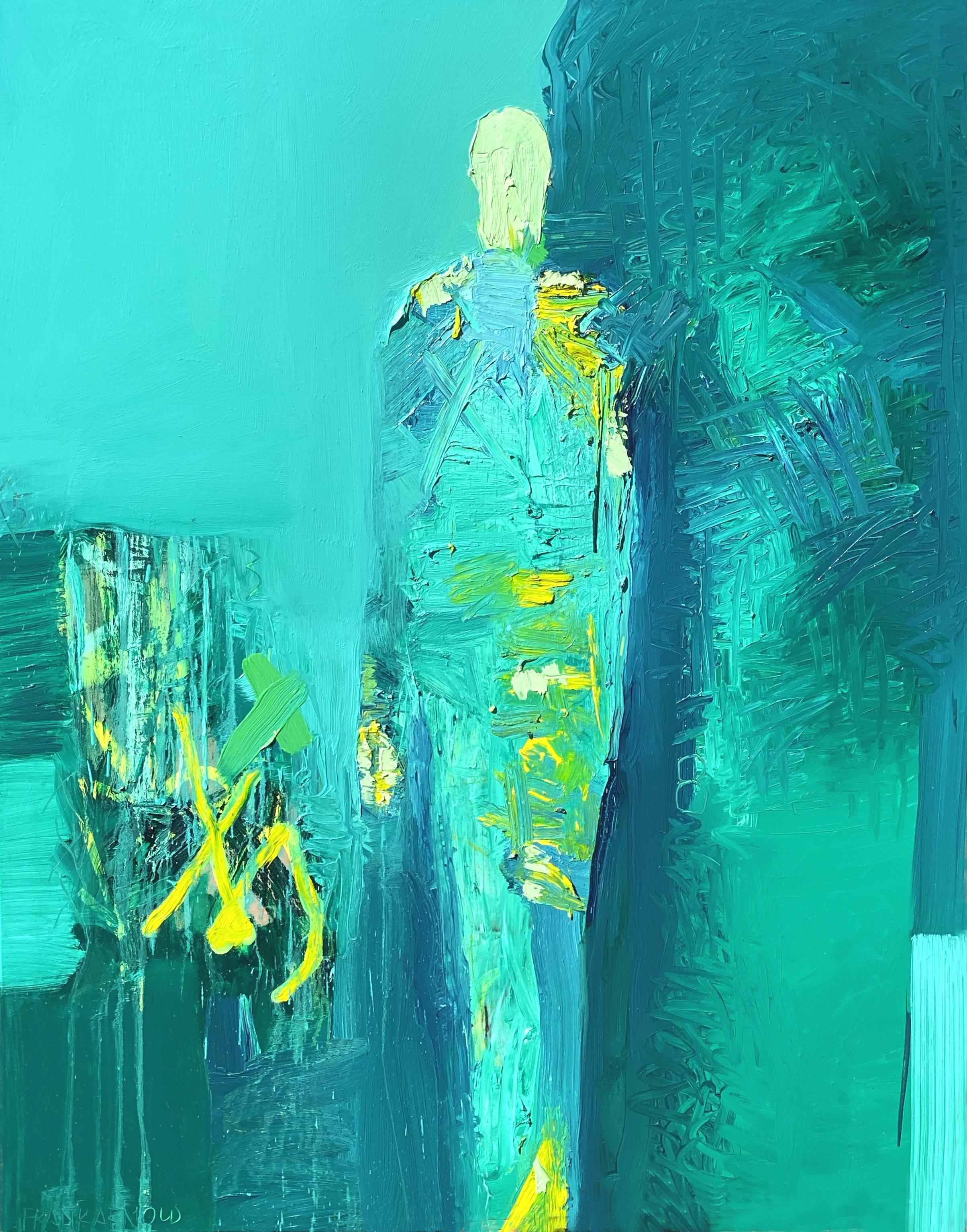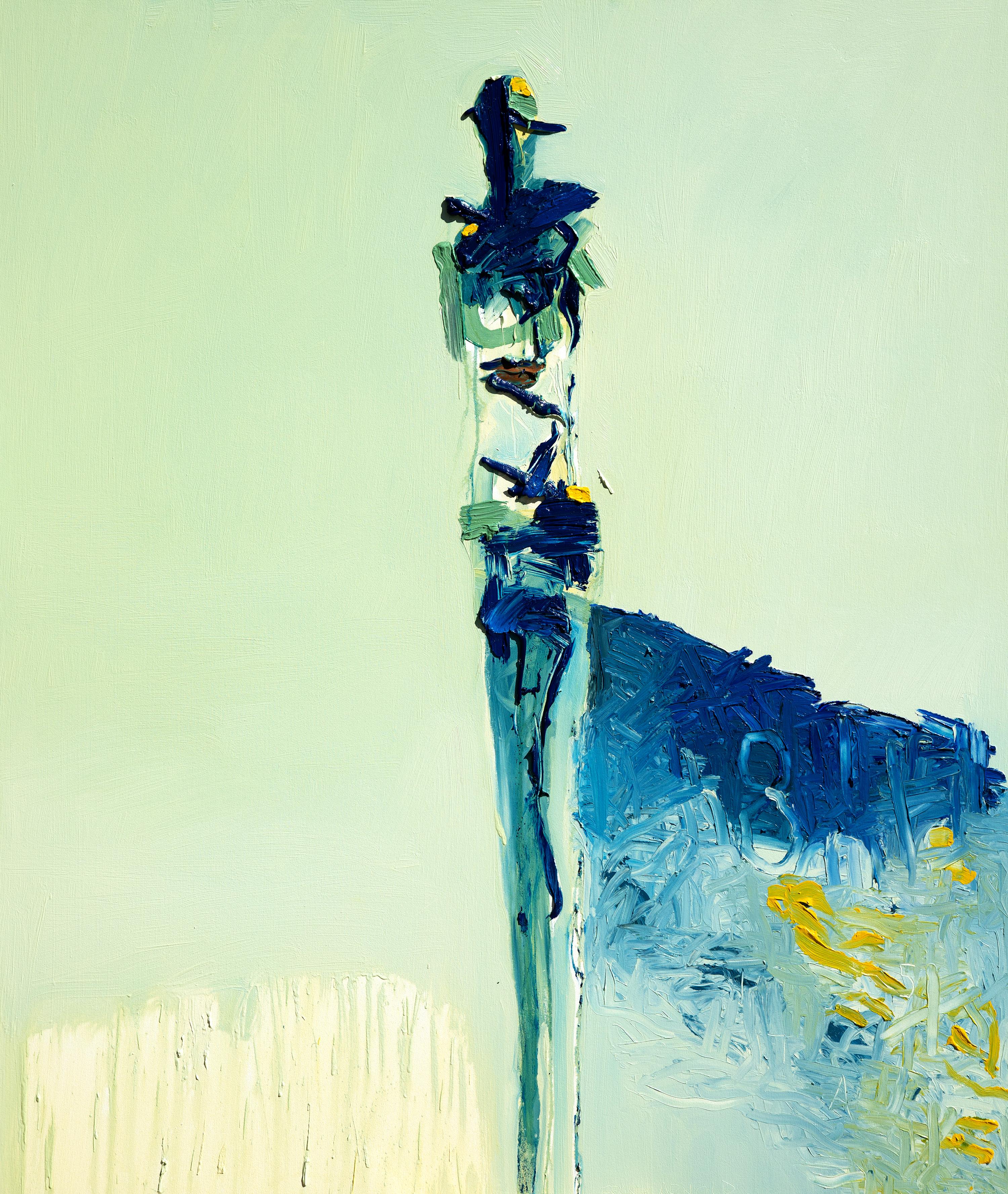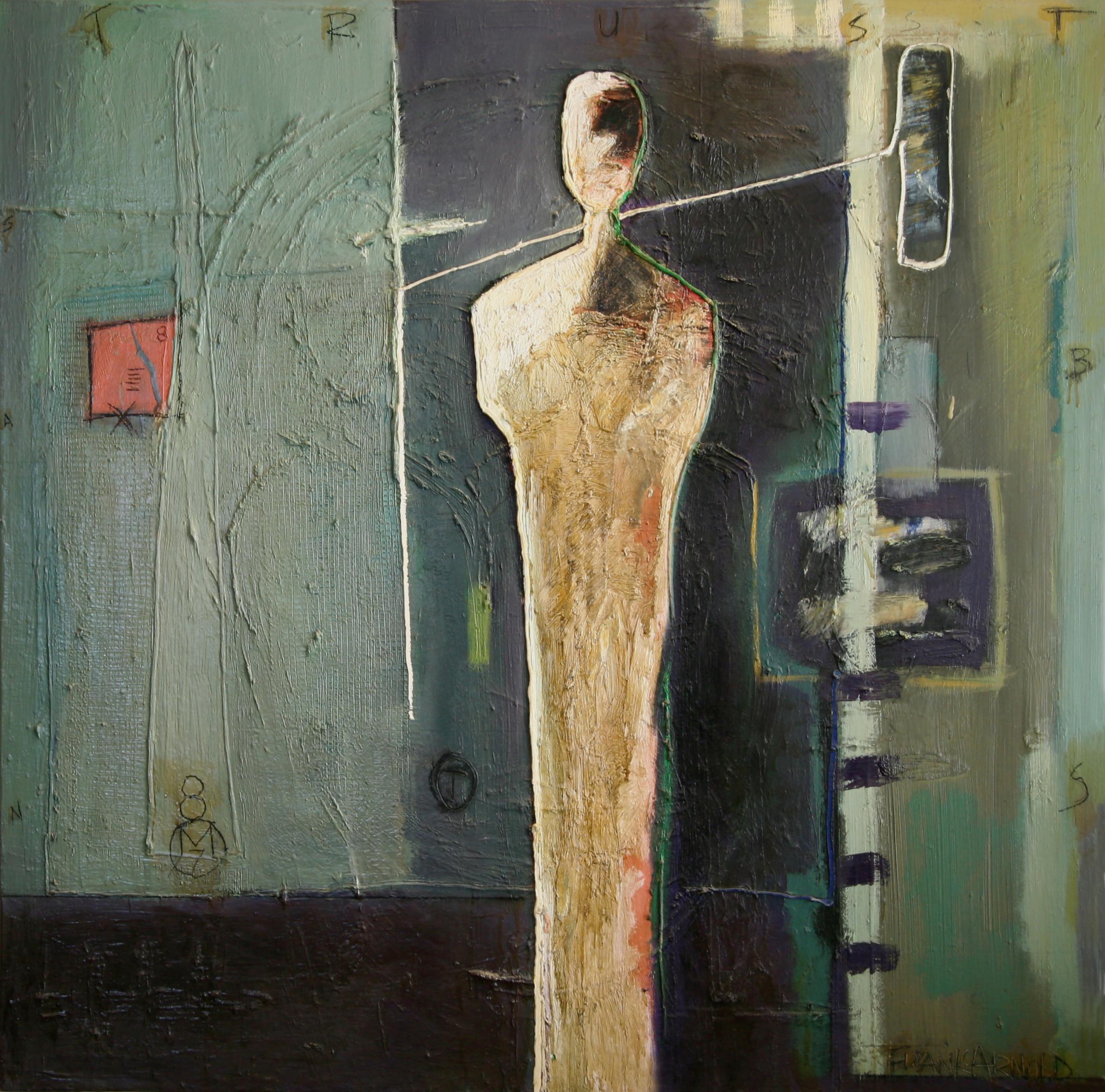Items Similar to Red Idol - British 50's art abstract oil painting - Modernist COBRA - provenance
Want more images or videos?
Request additional images or videos from the seller
1 of 7
William GearRed Idol - British 50's art abstract oil painting - Modernist COBRA - provenance1959
1959
About the Item
An original oil on canvas by the noted Scottish artist William Gear. A fabulous painting. One of his best and a seminal work which dates to 1959.
Provenance. Douglas Foulis Art Gallery 1963. Scottish Art Council No 33. Mr and Mrs Martin Tamworth-in-Arden.
Condition. Oil on canvas, 47 inches by 32 inches unframed and in good condition.
Housed in a gallery frame 55 by 40 inches framed. Excellent condition.
Few British painters have played an active role in the modern abstract movement of post-war Europe. William Gear was the most passionate and committed exception. He continued the tradition of the Edinburgh-Paris axis established by J.D. Fergusson, Samuel Peploe and others, spending vital years between 1947 and 1950 living and working in Paris. Significantly, in recent years, he received the greatest acclaim in France, Germany and the Netherlands.
He was born in 1915 in Methil, Fife, into a mining family; the particular landscape of "pitheads, the sea, rocks, castles, trees, storms and poverty" marked his earliest identity with a place and probably remained the most influential to his art. Years later he recalled as a schoolboy visiting the local art gallery in Kirkcaldy and seeing 12 colourful still-lifes by Peploe. Art-history lessons during student years at Edinburgh College of Art, in particular Byzantine classes under David Talbot Rice, also influenced his concern for structure. This had as much to do with the formal language of painting as sheer delight in the medium itself. Gear never missed an opportunity to show people the merits of a well-constructed painting.
On a travelling scholarship in 1937, he chose to study with Fernand Leger, described by Gear as "a keystone for me, seldom abstract, rather a degree of abstraction". The Second World War interrupted these formative years and, by 1940, Gear had joined the Royal Corps of Signals. Dispatched to the Middle East, he still had the discipline to paint - mostly works on paper of damaged landscapes - with exhibitions in Jerusalem, Tel Aviv, Cairo as well as Siena and Florence.
His naturally robust and tenacious temperament was profoundly affected by visiting Bergen-Belsen, and this certainly influenced the later experiments with the black armature. As the British officer in Celle, working for the Monuments, Fine Arts and Archives Section of the Control Commission, he focused on securing the safety of the Berlin Art Collection in Schloss Celle, and organised an important series of modern art exhibitions, including the rejected work of Karl Otto Gotz. Only a few weeks before his death, this service to "democratic art and artistic freedom" was recognised in Hanover by a unique Leporello Award, appropriately instigated by fellow artists and presented by the Lower Saxony government.
Demobbed in 1947, Gear headed for Paris, where he established a one-room studio at 13 Quai des Grands Augustins. This exciting period saw him gravitating towards what he called "the freer, dramatic approach of abstraction lyrique" rather then "the dogmatic hard-edged school of Mondrian and De Stijl". Within a year there were exhibitions at two of the pioneering salons and a first one-man show at the Galerie Arc en Ciel.
At the same time inclusion in Cobra shows in Amsterdam and Copenhagen in 1949, alongside Constant, Corneille and Appel, underpinned his affiliation to a reinvigorated form of abstract expressionism. He worked at the time in the fluid medium of opaque water-colour, usually on card with pockets of intense colour on a white or neutral ground. While some pieces were purely abstract, others carried their own suggestion of landscape, or even a form of Celtic figuration.
The same year saw an exhibition at the Betty Parsons Gallery in New York, alongside Jackson Pollock. The impact of American abstract expressionism however remained a sore subject, which in conversation was usually dismissed with a curt reminder of what he and others were already painting in Europe.
The decision to return to England in 1950 was both personal and practical. Recently married to Charlotte Chertok, and with a baby, he had already secured in 1948 the first of a series of London exhibitions with the Gimpel Fils Gallery. The atmosphere surrounding the Festival of Britain also appeared to offer fresh opportunities.
Notoriously, Gear was awarded one of the Festival of Britain Purchase Prizes for Autumn Landscape, a large oil on canvas which took six difficult months to complete. The event produced written questions and answers in the House of Commons and a tirade of abuse from the national press, not to mention a topic for debate on the radio programme Any Questions. While the episode made him a household name, the longer-term effects were, arguably, more detrimental.
He chose not to live in London or join fellow abstract artists in St Ives, preferring the independence of a village in Kent between 1953 and 1958. This period saw the continued development of large landscape structures, as well as "side-roads" into sculptural subjects and minimalist colour paintings, which openly acknowledged the influence of Nicolas de Stael. These works have still to be properly exhibited. Mau-Mau (1953), for example, painted for the Contemporary Art Society but at the last minute withdrawn from display at the Tate Gallery, has its first London showing in the current golden jubilee exhibition at the Redfern Gallery.
Gear was out of critical favour for most of the 1960s and 1970s. He exhibited more irregularly, despite returning to the use of dark structures broken by selected movements and light-inflected primary colours. While contemporaries questioned his move to Eastbourne as Curator of the Towner Art Gallery (1958-64), Gear's response was to take on the Purchase Committee. He changed the local authority's collection policy from Victorian and local views to securing the foundation of a major collection of post-war British art.
His move to Birmingham came with the appointment as Head of the Faculty of Fine Art, Birmingham College of Art, in 1964, a post held until retirement in 1975, by which time he had become increasingly un- interested in the growing bureaucracy surrounding art education. His support and encouragement to artists living in Birmingham however continued with the purchases made for Birmingham Museums and Art Gallery on behalf of the Friends organisation (1987-94) as well as for his own personal collection. Most recently he instigated the idea of a gallery of modern art in Birmingham.
Fortunately, the last 15 years have also gone some way to reverse the years of neglect. Gear and Stephen Gilbert (also Scottish) were the only British artists included in the major Cobra 1948-51 exhibition at the Musee d'Art Moderne, Paris, in 1982. The Cobra enthusiast Karel van Stuijvenberg has been a prominent patron and, in 1995, Gear took delight in attending the opening of the Cobra Museum of Modern Art in Amstelveen, near Amsterdam. He was equally proud of his long overdue election to the Royal Academy in 1995, and in the last years relished working with the fluidity and strong colours of oil stick. His work is exhibited and held by worldwide galleries including The Tate.
- Creator:William Gear (1915-1997, Scottish)
- Creation Year:1959
- Dimensions:Height: 55 in (139.7 cm)Width: 40 in (101.6 cm)Depth: 2 in (5.08 cm)
- Medium:
- Movement & Style:
- Period:
- Condition:
- Gallery Location:London, GB
- Reference Number:1stDibs: LU853113194702
About the Seller
5.0
Platinum Seller
These expertly vetted sellers are 1stDibs' most experienced sellers and are rated highest by our customers.
1stDibs seller since 2018
398 sales on 1stDibs
Typical response time: <1 hour
- ShippingRetrieving quote...Ships From: London, United Kingdom
- Return PolicyA return for this item may be initiated within 14 days of delivery.
More From This SellerView All
- Pavanne - 17th Century Court Dance - British exhibited Surrealist oil paintingBy John ArmstrongLocated in London, GBPainted by "Modern British" Surrealist artist John Armstrong this oil/tempera on board depicts Pavanne. The Pavanne is a 17th century Court dance. The figures bunch up rhythmically and are almost camouflaged in the darkness, almost invisible. Quite what the significance in 1944 of this historical subject is, we are not sure, but the dark overtones in the shadowy large figures with golden head and glowing hands make it quite a mystical work. It is an almost Surreal Modern British artwork and a very interesting painting. The work is painted by a very rare to find artist who is highly sought after. The painting was dirty when purchased. However since cleaning the 80 years of dirt away it has revealed the stunning figure group with their heads and golden hands and the signature and date in the lower right. A real gem of a painting has been revealed with the restoration clean. It is an important early British Surrealist work and has excellent provenance. Signed and dated 1944 lower right. Provenance. Alex Reid / Lefevre Galler 1945. Condition. oil/tempera on board, 34 inches by 20 inches unframed and in good condition. Housed in its original fine gallery frame, 43 inches by 29 inches framed and in good condition. John Rutherford Armstrong ARA (1893-1973) was a British artist and muralist who also designed for film and theatre productions. He is most notable for the Surrealist paintings he produced. Armstrong was born in Hastings in Sussex. His father was a clergyman and Armstrong was educated at St. Paul's School in London. He studied law at St. John's College, Oxford, but switched to art and became a student at St John's Wood Art School throughout 1913 and 1914. Armstrong served with some distinction in the Royal Field Artillery in Salonika during World War One before returning briefly to complete his studies at St John's Wood Art School. After a period of some economic hardship, Armstrong began to build a career as a theatre designer in London and to gain a client base for his artworks. He received a commission to decorate a room in the Portman Square home of the art collector Samuel Courtauld, and also painted a frieze for the ballroom at 1 Kensington Palace Gardens. Armstrong held his first solo exhibition in 1928 at the Leicester Galleries in London. In 1933 he joined Unit One and displayed a set of semi-abstract paintings at their one, extended, exhibition. Throughout the 1930s Armstrong continued to work as a designer as he also continued to develop his art. He produced a number of remarkable posters for Shell and also produced four posters for the General Post Office. Armstrong designed a number of book covers for the Hogarth Press...Category
1940s Surrealist Figurative Paintings
MaterialsTempera
- Landscape with White Bird - Welsh 1950's Abstract art oil painting natureBy Glyn MorganLocated in London, GBA Welsh artist, Morgan studied at Cardiff College of Art under Ceri Richards. He was a renowned imaginative artist and friend of Cedric Morris. He was influenced by the Benton End ar...Category
1950s Abstract Abstract Paintings
MaterialsOil
- New Vision - Canadian Abstract Expressionist art 60s oil painting landscape pinkBy William John Bertram NewcombeLocated in London, GBAn original large abstract oil on canvas by British Canadian artist William John Bertram Newcombe. This stunning abstract expressionist oil painting is a bold, adventurous and conf...Category
20th Century Abstract Expressionist Abstract Paintings
MaterialsMixed Media, Oil
- Essex Landscape - British 20th century Abstract art landscape oil paintingBy Lawrence SelfLocated in London, GBA large oil on canvas by noted abstract landscape artist Lawrence Self. Painted circa 1970 this is a fine large oil of an Essex landscape. A superb painting with lovely brushwork and...Category
20th Century Abstract Landscape Paintings
MaterialsOil
- Lonistum 1961 - Canadian British Abstract art oil paintingBy William John Bertram NewcombeLocated in London, GBAn original large abstract oil on canvas by British Canadian artist William John Bertram Newcombe. This stunning abstract expressionist oil in blues and greys is a bold, adventurous ...Category
1960s Abstract Abstract Paintings
MaterialsMixed Media, Oil
- Fifties Abstract - British 1954 abstract art oil painting Slade School artistLocated in London, GBThis superb British 1950's abstract oil on board painting is by noted Slade School trained contemporary artist Leo Davy. Davy was born in Yorkshire but settled in Cornwall in 1968 an...Category
1950s Abstract Abstract Paintings
MaterialsOil
You May Also Like
- Moving 5By Frank ArnoldLocated in Fresno, CA“Moving 5” is 60”x 48”. The vibrant yellow surface tones of this piece are broken in several places allowing random glimpses of Arnold’s dreamlike underpainting for a multi-dimension...Category
21st Century and Contemporary Abstract Abstract Paintings
MaterialsCanvas, Oil
- Oil on Canvas “Back Again”By Frank ArnoldLocated in Fresno, CAFrank Arnold is thought by many to be one of the foremost abstract figurative painters and sculptors of our time. He is a living master whose work is considered to be both personal a...Category
21st Century and Contemporary Abstract Abstract Paintings
MaterialsOil
- Oil on Canvas “A58”By Frank ArnoldLocated in Fresno, CA"A58" is 72” x 66”. The electric blues on black stand out from the figure on a mixed background of medium earth tones and heavy textures. Frank Arnold’s paintings exhibit the highest...Category
2010s Abstract Abstract Paintings
MaterialsCanvas, Oil
- Oil on Canvas "OTL 8"By Frank ArnoldLocated in Fresno, CA“OTL 8” is 60”x 60”. Central figure of Vibrant to deep reds on a split field of warm beige/coral and deep red/black. The foreground exhibits heavy strokes and Arnold’s “8” and “X” fi...Category
21st Century and Contemporary Abstract Abstract Paintings
MaterialsCanvas, Oil
- MentorBy Frank ArnoldLocated in Fresno, CA“Mentor” is 60”x 48” The impasto surface stages a bold sienna figure on a muted blue textured field. Frank Arnold’s paintings exhibit the highest quality materials for a truly archiv...Category
2010s Abstract Abstract Paintings
MaterialsOil
- Gone 5By Frank ArnoldLocated in Fresno, CA“Gone 5” is 40”x30” The impasto surface stages muted shades of greys and blue green enveloping the central figure. Frank Arnold’s paintings exhibit the highest quality materials for ...Category
2010s Abstract Abstract Paintings
MaterialsOil
Recently Viewed
View AllMore Ways To Browse
Playing Card Press
Vintage Royal Copenhagen Figure
Vintage Radio Service
Vintage Signal Light
Vintage Pocket Oiler
1970s Large Abstract Oil
Barbara Krupp Full Moon
Eitan Satat
Patricia Nix
Sheema Muneer
Canvas Art Painting
Abstract People
Small Blue Abstract
Paris 1956
Fluid Acrylic Art
Adams Painting
Sold Red Abstract
Rectangle Abstract Painting





